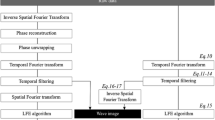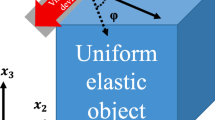Abstract
Magnetic resonance elastography (MRE) noninvasively images the propagation of mechanical waves within soft tissues. The elastic properties of soft tissues can then be quantified from MRE wave snapshots. Various algorithms have been proposed to obtain their inversion for soft tissue elasticity. Anomalies are assumed to be discernible in the elasticity map. We propose a new elastic level set model to directly detect and track abnormal soft tissues in MRE wave images. It is derived from the Mumford-Shah functional, and employs partial differential equations for function modeling and smoothing. This level set model can interpret MRE wave images without elasticity reconstruction. The experimental results on synthetic and real MRE wave images confirm its effectiveness for soft tissue discrimination.
Access this chapter
Tax calculation will be finalised at checkout
Purchases are for personal use only
Preview
Unable to display preview. Download preview PDF.
Similar content being viewed by others
References
Greenleaf, J.F., Fatemi, M., Insana, M.: Selected methods for imaging elastic properties of biological tissues. Annual Review on Biomedical Engineering 5, 57–78 (2003)
Manduca, A., Oliphant, T.E., Dresner, M.A., Mahowald, J.L., Kruse, S.A., Amromin, E., Felmlee, J.P., Greenleaf, J.F., Ehman, R.L.: Magnetic resonance elastography: Non-invasive mapping of tissue elasticity. Medical Image Analysis 5, 237–254 (2001)
Manduca, A., Muthupillai, R., Rossman, P.J., Greenleaf, J.F., Ehman, R.L.: Image processing for magnetic resonance elastography. In: Proc. SPIE, vol. 2710, pp. 616–623 (1996)
Oliphant, T.E., Manduca, A., Ehman, R.L., Greenleaf, J.F.: Complex-valued stiffness reconstruction for magnetic resonance elastography by algebraic inversion of the differential equation. Magnetic Resonance in Medicine 45, 299–310 (2001)
Kwon, O.I., Park, C., Nam, H.S., Woo, E.J., Seo, J.K., Glaser, K.J., Manduca, A., Ehman, R.L.: Shear modulus decomposition algorithm in magnetic resonance elastography. IEEE Transactions on Medical Imaging 28(10), 1526–1533 (2009)
Osher, S., Fedkiw, R.: Level Set Methods and Dynamic Implicit Surfaces. Springer, Heidelberg (2003)
Sethian, J.A.: Level Set Methods and Fast Marching Methods. Cambridge University Press, New York (1999)
McLaughlin, J., Renzi, D.: Using level set based inversion of arrival times to recover shear wave speed in transient elastography and supersonic imaging. Inverse Problems 22, 707–725 (2006)
Ammari, H., Garapon, P., Kang, H., Lee, H.: A method of biological tissues elasticity reconstruction using magnetic resonance elastography measurements. Quarterly of Applied Mathematics 66(1), 139–175 (2008)
Chan, T.F., Vese, L.A.: Active contours without edges. IEEE Transactions on Image Processing 10(2), 266–277 (2001)
Tsai, A., Yezzi, A., Willsky, A.S.: Curve evolution implementation of the Mumford-Shah functional for image segmentation, denoising, interpolation, and magnification. IEEE Transactions on Image Processing 10(8), 1169–1185 (2001)
Mumford, D., Shah, J.: Optimal approximation by piecewise smooth functions and associated variational problems. Commu. Pure Appl. Math. 42, 577–685 (1989)
Manduca, A., Lake, D.S., Kruse, S.A., Ehman, R.L.: Spatio-temporal directional filtering for improved inversion of MR elastography images. Medical Image Analysis 7, 465–473 (2003)
Grimm, R.C., Lake, D.S., Manduca, A., Ehman, R.L.: MRE/Wave. Mayo Clinics, Rochester, MN, USA, http://mayoresearch.mayo.edu/ehman_lab/
Author information
Authors and Affiliations
Editor information
Editors and Affiliations
Rights and permissions
Copyright information
© 2010 Springer-Verlag Berlin Heidelberg
About this paper
Cite this paper
Li, B.N. et al. (2010). Soft Tissue Discrimination Using Magnetic Resonance Elastography with a New Elastic Level Set Model. In: Wang, F., Yan, P., Suzuki, K., Shen, D. (eds) Machine Learning in Medical Imaging. MLMI 2010. Lecture Notes in Computer Science, vol 6357. Springer, Berlin, Heidelberg. https://doi.org/10.1007/978-3-642-15948-0_10
Download citation
DOI: https://doi.org/10.1007/978-3-642-15948-0_10
Publisher Name: Springer, Berlin, Heidelberg
Print ISBN: 978-3-642-15947-3
Online ISBN: 978-3-642-15948-0
eBook Packages: Computer ScienceComputer Science (R0)




